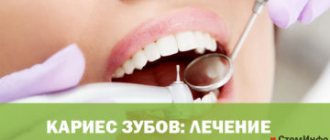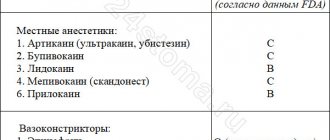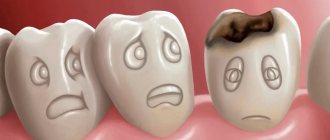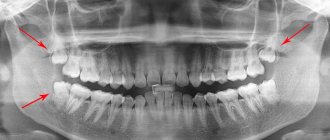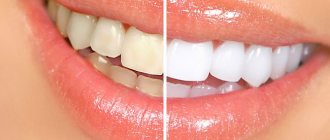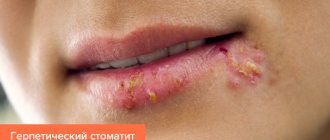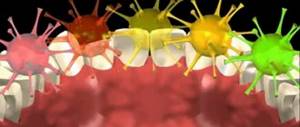Almost every inhabitant of the planet suffers from caries, and many people are afraid of preparing teeth with a drill. In this regard, modern conservative treatment methods, which allow you to cure a tooth without surgical intervention, are of particular relevance. One of these methods is ICON - we’ll explain what it is and how it works in the article.
In this article
- What are caries?
- What is microinvasive caries treatment and when is it used?
- Treatment of caries using the ICON method - what is this technology?
- How is caries treatment performed using the Icon method?
- When is it prohibited to use the technique?
- Treatment with the ICON method: main advantages
Methods for treating caries without drilling
Getting rid of caries without using a drill is the dream of every dental patient.
Not so long ago, it seemed absolutely unattainable. But technology is developing, new, more gentle, effective methods are constantly appearing. Today, treating caries without drilling is a completely common procedure. From a clinical point of view, caries is divided into 4 main stages of development. Gentle treatment methods, without the use of a drill, are used only in the initial stages of the disease, when the carious lesion has not penetrated deeper than the enamel. New technologies make it possible to stop the pathological process when a cavity has just begun to form in the fissure, without waiting for further destruction of dental tissue. Treatment of caries without a drill is carried out using the infiltration method, using ozone therapy, laser, and air abrasive effects.
Stages of caries on children's teeth
- Initial - whitish or yellowish spots appear on the enamel. Treatment of this stage of caries is carried out without a drill, using the ICON technique or alternative techniques.
- Superficial – the first enamel defects are observed, but dental treatment can still be carried out without drilling.
- Medium – a shallow carious cavity is visible on the tooth, which requires cleaning and subsequent filling.
- Deep - severe caries, when the dentin is already seriously affected, and the child feels pain when eating.
ICON or liquid filling
The infiltration method of treatment (ICON) consists of using a special light-composite polymer, which fills the pores of the enamel, sealing the affected area. The treatment mechanism is quite simple:
- The carious lesion is covered with a special gel that splits the surface enamel layer (enamel etching).
- After removing the gel, the tooth surface is dried, and a polymer material is applied to fill the porous structure of the enamel, blocking the path for the spread of bacteria that cause caries.
- The infiltrate is polymerized using a special lamp.
The ICON treatment method does not require mechanical action on dental tissue. The procedure is painless, lasts 10-15 minutes, and is used to eliminate superficial caries. Excellent for patients who are contraindicated for anesthesia - allergy sufferers, children, pregnant women.
Air abrasive sanitation
Treatment involves treating the carious lesion with an air stream to which abrasives are added. The mixture with solid particles mechanically affects the area, “knocking out” the affected and softened tissues without harming the hard, healthy ones. The method, developed in the mid-twentieth century in the USA, is effective at the initial stage of caries, it is painless and anesthetic injections are not required during treatment.
“Sandblasting” flow-abrasive devices initially treated teeth with quartz sand, but this was later replaced by non-toxic aluminum oxide. Progressive devices (such as the RONDOflex tip) are used in the treatment and professional hygiene of the oral cavity; they qualitatively expand and open fissures, remove medical cement from crowns and braces, and clean the enamel from surface stains. When using the devices, the risk of secondary caries is minimized; the equipment operates without noise, vibration, or heating of tissues.
Treatment is carried out pulsed, affecting the selected area for 6-10 seconds in a row. In “advanced cases,” drilling cannot be avoided—this, in particular, affects areas inaccessible to equipment tips. The disadvantages of the method include its use only for superficial caries and increased sensitivity of the tooth after treatment.
Ozone treatment
The technique is based on the effect of ozone on the carious lesion. A special cap connected to ozone therapy equipment is put on the tooth. Exposure to ozone has a detrimental effect on pathogens. After disinfection, a special sealing agent is applied to the affected area. This method is used to treat caries in the spot stage, fissure, and molar surface caries. Ozone therapy is used for antiseptic treatment of carious cavities at any stage of the disease, as well as in the treatment of gingivitis, periodontitis and other periodontal pathologies.
METHOD 2: Eliminating caries without a drill using ozone therapy
Elimination of the carious process in the first stages, when the process has not yet developed to the point of a tooth enamel defect in the form of a cavity, but a non-pigmented carious spot has formed - this is possible with the help of an innovative device - the ozone generator Heal Ozone (KAVO) Germany. In this situation, it is possible to avoid drilling and traumatizing the enamel, and it is also possible to keep the tooth structure intact if it is necessary to eliminate the initial dental caries, the beginning process of “rotting” in the grooves of the tooth, and the carious process of the frontal parts of the teeth in the stage of demineralization.
Today this is a method recognized in the global dental community.
A special gaseous chemical substance, built on the basis of oxygen and having the ability to quickly disintegrate, is called ozone. Consisting of 3 oxygen molecules, this gas, when applied to it by physical factors that change the structure of the molecule (light wave, electric discharge), degrades into two chemical particles, one of which is a super active oxygen particle. The atomic oxygen molecule easily interacts with and reacts with any chemical. elements, turning them into oxides and changing their chemical properties. When interacting with substances that are part of the cell membrane of a pathogenic microorganism or virus, their death is caused. The highly active oxygen atoms released as a result of the reaction are destructive for pathogenic microorganisms. Consequently, during the action of ozone on the tooth, microorganisms that cause caries are destroyed.
The technique was first used by doctors from Germany and is highly effective.
Ozone is supplied to the demineralized area of the tooth through a specially designed nozzle. The procedure is not accompanied by sound, smell and is completely painless. Clearly measured portions of gas are supplied through the tube from the ozone generator. Negative pressure is created around the area of damaged enamel, as a result of which the nozzle of the device fits tightly to the tooth, creating a rarefied atmosphere. In 15-45 seconds, the active gas disinfects and sterilizes hard enamel tissue, killing pathogenic microorganisms that cause caries. To achieve a therapeutic effect, you should treat the tooth only once, and then carry out at least 1 procedure every six months. The ozone therapy procedure is followed by a special treatment of the tooth enamel: dentists apply a patented HealOzone liquid to the surface of the tooth, which causes mineralization (strengthening) of the tooth.
The liquid does not cause irritation to the soft tissues of the tooth and is safe for patients of any age. Patients are recommended to use the liquids from the HealOzone kit at home every day for 5 weeks, providing a long-term reliable supply of mineral components to strengthen tooth enamel.
- Removal of the carious process in the stage of white spot and surface demineralization of the tooth.
- Elimination of the carious process in a groove or blind fossa within the enamel at a stage when the cavity has not yet formed.
The ozone therapy procedure is indicated for use and gives maximum effect in cases where the dentist discovered tooth decay from the very beginning and it did not have time to form a cavity.
Laser technologies
Dental tissue preparation is performed non-contactly using a laser. The doctor adjusts the length of the laser beam according to the clinical picture. The radiation affects only the affected tissue, healthy tissue is not involved. Another advantage of the method is the absence of the vibration effect that occurs when the drill is operating. And this eliminates the risk of cracks and chips in the enamel. Laser radiation has a bactericidal effect; after treatment, the carious cavity is absolutely sterile; after filling, the development of secondary caries is excluded.
Treatment without a drill, using laser technologies, can be used both in the initial stages of caries and in cases of noticeable damage to the tooth, when it is necessary to place a filling. The procedure is painless, harmless, and is indicated for patients with special sensitivity, including children and pregnant women.
Laser dental treatment without a drill
Treatment of caries with a laser, in other words, laser fluorescence, as well as the above methods, implies the treatment of caries without drilling in the sense in which we are accustomed to understanding drilling and the associated discomfort.
Why does unpleasant pain occur while the drill is working? The fact is that intense heating and friction occurs between the dental drill and enamel, dentin. And to these sensations is added vibration that spreads to the dental tissues. During laser treatment, tissue heating does not occur due to the low radiation power. In addition, laser devices are 20 times quieter than a drill! In this case, the main thing is not to accidentally fall asleep in the dentist’s office. It is not without reason that this method is recommended not only for people with increased sensitivity to pain and sounds, but also for those most sensitive to the perception of external stimuli - pregnant women and children. In addition, the procedure for laser treatment of caries is absolutely sterile - the tip of the installation does not come into contact with the teeth. The laser performs cavity preparation by selectively affecting caries, or, more precisely, only tissue infected with caries. The impact completely suppresses the growth of carious bacteria and eliminates the risk of secondary caries. At the same time, the laser method does not harm healthy teeth, and also does not lead to microcracks in the enamel. And the time spent on treating caries is reduced by about 40% compared to traditional treatment - there is no need to change attachments, and when treating superficial caries, there is no need to use anesthesia. Today, dentistry uses lasers not only as a method of treating caries, but also as a diagnostic method. The second is a significant advantage compared to X-ray diagnostics, since in the case of laser “checking” there is no radiation.
Disadvantages of treating caries without drilling teeth
- high cost of laser installation
- high demands on specialists working with lasers
- treatment requires the use of protective dark glasses by both the patient and the doctor
- glasses with tinted lenses can distort the reality and reduce the clarity of vision
- in some cases, soft tissue damage caused by lasers heals slowly and poorly
- there is also a possibility that the laser will be reflected from metal objects in the dentist's office, if they are not removed, and cause a fire
Prevention of caries
Regular oral hygiene will help maintain dental health. You need to brush your teeth twice a day, using fluoride toothpastes and mouth rinses. Don't forget to use dental floss and irrigator. You can prevent tooth decay by limiting your carbohydrate intake. Sweets, baked goods, and carbonated drinks leave sticky residues that serve as a breeding ground for oral microflora. Bacterial plaque forms faster, which increases the risk of developing caries.
An important condition for caries prevention is visiting the dentist at least 2 times a year for examination and hygienic cleaning. Regular inspections allow you to detect problems at an early stage. In this case, it is possible to treat caries without drilling, using non-invasive technology.
Causes of caries of primary and permanent teeth in children
- Poor oral hygiene. Children rarely like to brush their teeth, so parents should ensure quality care twice a day, rinsing their mouth after meals.
- Imbalance in the menu. It is necessary to include solid vegetables and fruits in the child’s diet, and minimize the amount of sweet and carbohydrate foods.
- Transmission of infection from parents. Adults should not kiss a child on the lips or lick baby spoons or pacifiers.
- Hereditary factor. Dental health is genetic, so parents can assess risks based on the frequency of their dental appointments.
Infiltration
One of the most progressive methods of eliminating caries is infiltration. It is a microinvasive mechanical-chemical treatment that does not involve drilling. The technique, based on treating the affected area with gels and polymer resins, has many advantages:
- high effectiveness of treatment at the stain stage, after removing braces - for deeper lesions, a traditional drill will be needed;
- stopping the development of caries and preventing its further progression;
- safety and painlessness of treatment for patients - non-toxic compounds are used, no anesthetic injections are needed (the procedures are carried out even if you are allergic to painkillers);
- speed of treatment - removal of the affected area and treatment takes no more than half an hour;
- non-traumatic effect on teeth - during treatment, microcracks do not occur, the healthy part of the teeth is not affected.
The technique is mainly used for caries in the early stages, when it is difficult (or impossible) for the patient to detect it on their own. Therefore, when choosing treatment without a drill, you need to regularly visit the dentist for preventive maintenance. The specialist will identify the lesion, apply an infiltration gel to it, which breaks down the enamel, and dry the area with alcohol in a 99% concentration. After air treatment, the tooth is coated with polymers. The method is used mainly on smooth surfaces, for lesions with smooth edges and an expanded “entrance”.
Icon - progressive infiltration therapy
Icon is a type of infiltration treatment that uses special devices and compounds. The technology has proven effective in the fight against caries in patients of all ages; it is comfortable, non-painful and therefore is indicated for everyone who does not want or cannot resort to anesthetics. The advantage of the Icon method is psychological comfort, absence of radiation, noise, vibration. The hygiene of the treatment is ensured by the use of a rubber dam. The latex layer protects the oral cavity when removing tissues affected by caries, and the contact of gel or alcohol with the mucous membrane or healthy teeth is excluded.
Each procedure has advantages and disadvantages, so the dentist makes the decision on choosing a treatment method after examining the patient. The latter can resort to “home”, folk remedies - even if they do not eliminate caries, in some cases they can prevent it.
How does ICON technology work?
At the beginning of carious disease, a section of enamel that has begun to rapidly lose minerals becomes porous due to the formation of microcavities, and begins to quickly thin out. In the central part of such a spot - the “bottom” - the percentage of voids can reach 25% or more. Cariogenic bacteria settle in the resulting microcavities, which actively produce lactic acid and the loss of minerals continues to increase. The loose, damaged layer of enamel is covered on the outside with a dense microfilm, which forms on the surface of the spot due to remineralization by saliva, and the pathological process underneath is in full swing.
The infiltration method involves removing this microfilm using a special substance ICON based on 15% hydrochloric acid, because it interferes with access to the spongy underlying tissues. Then the surface is dehydrated, i.e. Water is removed from the tissues using a special preparation based on ethyl alcohol, and all pores in the affected area are filled with a special mixture of synthetic resins with increased penetrating ability. This substance is absorbed by the tooth tissues and “seals” the area of the beginning of the lesion, thus stopping the carious process.
